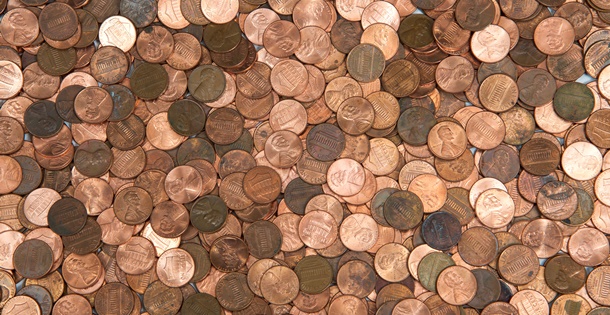May 23 was Lucky Penny Day, and the penny is lucky indeed. Consider that they’re still being made today, even though they lost their usefulness long ago. In fact, the government spends millions to turn out a new supply, even knowing a penny isn’t even worth a penny. Here are seven reasons to put an end to this coin.
1. It’s a Money Loser for the Government
Back in 1909, when the penny was introduced for the centennial of Lincoln’s birth, it was made with 95% copper. And because copper had strong market value then, each penny was actually worth 2.5¢.
Copper is still valuable today, but pennies aren’t. In 1982, the copper content of pennies was reduced to just 2.5%. The rest is inexpensive zinc. But even this cost-cutting move hasn’t helped; our 1¢ costs 1.8¢ to make.
The government currently spends $46 million on minting pennies every year.
It’s worth nothing that several countries have started the process of removing the penny from their currency: Canada, Australia, Russia, Belgium, Italy, the Netherlands, and Brazil.
2. It’s a Money Loser for You
The penny can buy nothing of value today. Its purchasing power is so low, it’s provided free for the taking in many stores. And, as economist Greg Mankiw has observed, “When people start leaving a monetary unit at the cash register for the next customer, the unit is too small to be useful.”
Today, the average hourly wage in the U.S. is over $22 an hour. Which means the average worker earns 6/100ths of a cent every second. If you take three seconds to stop and pick up a penny, you’re losing money, not gaining it.
The reasons the government has to produce so many new pennies each year is because Americans simply discard them, or use them to fill jars.
3. It’s a Money Loser for Retailers
The job of counting, sorting, and hauling around pennies represents added expense for cashiers and store managers. Thirty years ago, our defense department prohibited the use of pennies at military bases overseas. When officials considered the weight of pennies, they determined the coins simply weren’t worth the cost of shipping them to or from foreign countries.
4. Vending Machines Don’t Want Them
The only machines still willing to accept pennies are at toll booths, notably those in the Land of Lincoln.
5. We’re Moving Away from Currency
As of 2016, only 24% of Americans reported making most or all of their purchases with cash, down from 36% five years earlier, according to Gallup.
6. We Have a Precedent for Eliminating Worthless Coins
America began minting half pennies in 1793. By 1821, when the Post began publishing, the coin had the purchasing power of today’s dime. But by 1857, the half penny had lost so much value, the mint ceased its production.
7. We Won’t Forget President Lincoln
He’s still on the $5 bill, a piece of currency that’s far more worthy of the 16th president.
So why does the U.S. Mint continue turning out pennies? Partly it’s sentiment. Most Americans have an attachment to the coin and want to see it remain in circulation. They remember collecting pennies as children and that memory lingers.
Another reason is the government’s resistance to reducing inefficiency. As President Obama said in 2014, “One of the things you see chronically in government, it’s very hard to get rid of things that don’t work so that we can then invest in the things that do.”
Not all pennies are useless. In 2010, a rare 1943 penny sold for $1.7 million. That alone might be a good enough reason for following the old adage, “find a penny, pick it up” (while you still can).
Featured image: Shutterstock
Become a Saturday Evening Post member and enjoy unlimited access. Subscribe now




Comments
Is a penny saved still a penny earned?
Eric R said it all.
Correct logic that should be required reading for all.
Eliminating the penny doesn’t fix the problem with government spending. Anyways, the government will have to invest on producing more nickels and maybe dimes. That means more money for taxpayers to pay for. Yes, not a lot of people use pennies so maybe we just don’t produce so much. That will somewhat fix the government spending problem and taxpayers wont have to pay for so much. This will give the government money to get rid of national debt.
When I visited Canada 3 times this decade, they did not have pennies & they are doing fine. We should subtract from the US $25 Trillion deficit, not add to it. Let’s rally to make the last pennies in 2020 then be done with them. The mint should take what ever pennies make it to Federal Reserve Banks & recycle the metal to make more valuable coins such as the nickel through quarter. Maybe this should go to a national vote in 2020 to not make pennies anymore.
My essay for school was longer than this article
This isn’t very hard- it’s not like we don’t have a very similar example from Canada. They dropped the penny and rounding happens just the way you learned in like 2nd grade.
A $7.12 bill would be $7.10, so if you have that dime, you still don’t have to break a dollar. If you have ten pennies for one reason or another, they will still be accepted and you can use them. If you pay with credit or debit card, it is $7.12.
As far as retailers setting prices to round in their favor? How the hell would that work? I’m in NYS with 8% sales tax. If I buy a widget for $5.99 it is $6.47 with tax and that would round down to $6.45. So you are saying that the retailer is going to make the price $6.00 so that it rounds up to $6.50. OK Great, two issues there:
(1) This flies in the face of dozens of years of psychology on $x.9x pricing. It takes only a very tiny edge with that pricing scheme, to be worth more than the rounding.
(2) It breaks down when you aren’t only thinking about single item purchases. If I’m buying two widgets, it comes out the same at $5.99 or $6.00, so see #1. If I buy three of them, now the consumer comes out ahead by the nickel and back to #1, the store loses out as people will be less inclined to buy the product at all.
like for real who smells pennies!!!
why does this kid smell pennies.
I, for one, do not like the idea of getting rid of either pennies or cash, no matter what this article seems to think. I think both have an important role to play in our society! Where’s the value in a piece of plastic that seems to make people’s life easier. I would rather have access to cash in any eventuality!
The article is right.
i smell penniessssssssssss
Kirk, I wish retailers would do that; with the amount including sales tax be to the nearest whole number or one ending in a 5, 15, 25 etc. As it is, I use my VISA debit card for nearly all purchases over $5.
When I DO use cash at Sprout’s buying groceries and vitamins, it’s almost always in conjunction with the card, where no change would be involved anyway.
Say for example, my checking account (on a particular day) can’t handle the $57.75 withdrawal from it, I always have extra $10s and $20s in my wallet just for those occasions to reduce the amount being taken out with the card.
We are largely a cashless society now, but in an instance such as I mentioned, cash itself is still important. (I also know how VERY nice it is to be paid ‘under the table’ in cash).
If it isn’t one kind of crime involving money, it’s another. Eliminating cash would decrease bank robberies (not jewelry store stores though) but cyber money crimes would become a bigger problem than they are now, which is considerable. This is why we have to look at our bank accounts online everyday to check for fraud, and get on it immediately if needed.
Also, it’s really NOT a good idea to try to do your banking with smart phone apps. It’s just what cyber hackers are looking for. If you don’t have automatic deposit, thou best taketh thy check to the branch with a deposit slip and get thy receipt on paper.
I simply leave pennies on the counter or put them in a contribution jar that is often at checkout stands.
Retailers would simply set prices so that, with sales tax, the amount would round to the nearest whole number in your change. $7.12 would be $7.10, for example. But soon enough we will become a cashless society, which would enormously reduce crime. The times they are a-changing. . . .
We still need them for getting exact change back when making store purchases using cash; that’s the thing. And, if something’s $7.12, it’s nice to have a dime & 2 pennies handy rather than breaking another dollar and having 88 cents weighing down your pocket.